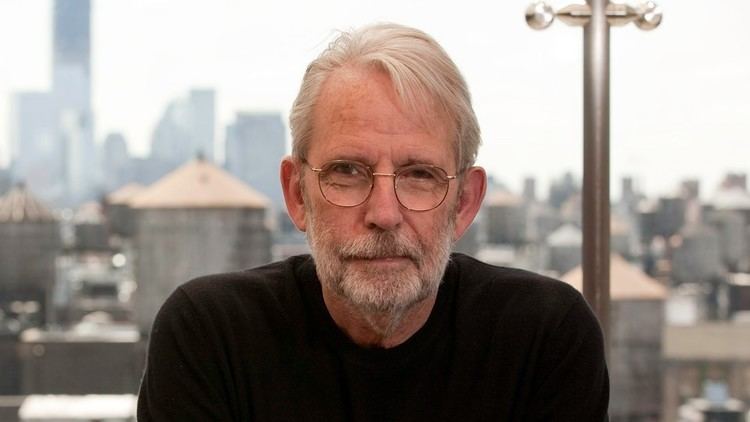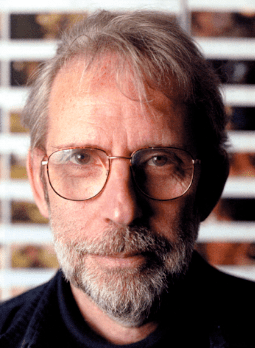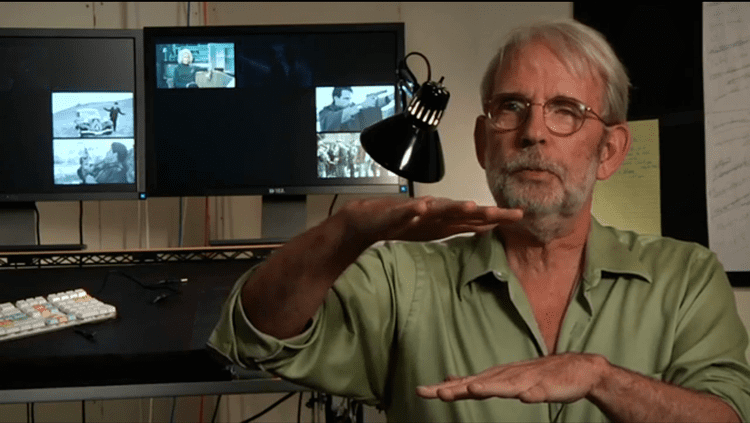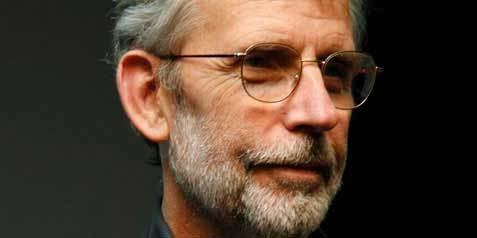Role Film Editor Name Walter Murch | Years active 1969–present Education Johns Hopkins, BA 1965 Spouse Aggie Murch (m. 1965) | |
 | ||
Full Name Walter Scott Murch Born July 12, 1943 (age 82) ( 1943-07-12 ) New York City, New York Occupation Film editor, Sound designer Books In the blink of an eye, Return to Oz Children Connie Angland, Walter Slater Murch, Carrie Angland, Beatrice Murch Parents Walter Tandy Murch, Katharine Murch Movies Return to Oz, THX 1138, The Black Stallion Similar People Profiles | ||
Walter murch 2015 fcpx avid premiere pro
Walter Scott Murch (born July 12, 1943) is an American film editor and sound designer. With a career stretching back to 1969, including work on Apocalypse Now, The Godfather I, II, and III, American Graffiti, The Conversation, and The English Patient, with three Academy Award wins (from nine nominations: six for picture editing and three for sound mixing), he has been referred to as "the most respected film editor and sound designer in the modern cinema."
Contents
- Walter murch 2015 fcpx avid premiere pro
- Walter murch on editing
- Early life
- Career
- Innovations awards
- Personal life
- References

Walter murch on editing
Early life

Murch was born in New York City, New York, the son of Katharine (née Scott) and Canadian-born Walter Tandy Murch (1907–1967), a painter. As a boy, he began to experiment with sound recording, taping unusual sounds and layering them into new combinations. He attended The Collegiate School, a private preparatory school in Manhattan, from 1949 to 1961. In the summer of 1961 he worked as a music librarian and production assistant at newly-founded radio station WRVR. He assisted with the July 29th 1961 live broadcast of a 12-hour folk music Hootenanny produced by Izzy Young. This featured, among many other acts, the first radio performance of the 20-year-old Bob Dylan . Murch then attended Johns Hopkins University from 1961 to 1965, graduating Phi Beta Kappa in Liberal Arts. Murch spent the university school year 1963-1964 in Europe, studying Romance Languages and the History of Art in Italy at Perugia and in France at the Sorbonne.
While at Johns Hopkins, he met future director/screenwriter Matthew Robbins, cinematographer Caleb Deschanel, and philosopher Andrew Feenberg, with whom he staged a number of happenings. In 1965, Murch and Robbins enrolled in the graduate program of the University of Southern California's film school, encouraging Deschanel to follow them. There all three encountered, and became friends with, fellow students such as George Lucas, Hal Barwood, Robert Dalva, Willard Huyck, Don Glut and John Milius; all of them would go on to be successful filmmakers. Not long after film school, in 1969, Murch, Lucas, and others joined Francis Ford Coppola at American Zoetrope in San Francisco. Murch and his family settled in Bolinas, California, in 1972.
Career

Murch started editing and mixing sound with Francis Ford Coppola's The Rain People (1969). Subsequently, he worked on George Lucas's THX 1138 and American Graffiti and Coppola's The Godfather before editing picture and mixing sound on Coppola's The Conversation, for which he received an Academy Award nomination in sound in 1974. Murch also mixed the sound for Coppola's The Godfather Part II which was released in 1974, the same year as The Conversation. He did sound design work on Apocalypse Now, for which he won his first Academy Award in 1979. (He was also significantly involved in the re-editing work that resulted in the extended Apocalypse Now Redux in 2001.) In 1985 he directed his own film, Return to Oz, which he co-wrote with Gill Dennis.

Murch edits in a standing position, comparing the process of film editing to "conducting, brain surgery and short-order cooking", since all conductors, cooks and surgeons stand when they work. In contrast, when writing, he does so lying down. His reason for this is that where editing film is an editorial process, the creation process of writing is opposite that, and so he lies down rather than sit or stand up, to separate his editing mind from his creating mind.
Murch has written one book on film editing, In the Blink of an Eye (1995), which has been translated into many languages including Chinese, Italian, Hebrew, Spanish, French, German and Hungarian. Before this, he wrote the foreword to Michel Chion's Audio-Vision: Sound on Screen (1994). He was also the subject of Michael Ondaatje's book The Conversations (2002), which consists of several conversations between Ondaatje and Murch; the book emerged from Murch's editing of The English Patient, which was based on Ondaatje's novel of the same name.
In 2007 the documentary Murch premiered at the San Francisco International Film Festival, which centered on Murch and his thoughts on filmmaking.
In 2012, Murch's translations of short stories by the Italian writer Curzio Malaparte were published as The Bird That Swallowed Its Cage.
Murch directed just one film in his entire career, the fantasy Return to Oz (which he co-wrote) in 1985. After the film failed at the box office, he never directed another film again.
Innovations & awards
While he was editing directly on film, Murch took notice of the crude splicing used for the daily rough-cuts. In response, he invented a modification which concealed the splice by using extremely narrow but strongly adhesive strips of special polyester-silicone tape. He called his invention "N-vis-o".
In 1979, he won an Oscar for the sound mix of Apocalypse Now as well as a nomination for picture editing. The movie was among the first stereo films to be mixed using an automated console. Additionally, the film is the first to credit anyone as Sound Designer, a professional designation that Murch is widely attributed to have coined as a means to help legitimate the field of post-production sound, much in the way William Cameron Menzies coined the term "Production Designer" in the 1930s.
Apocalypse Now was also notable for being the first film to be mixed in what has come to be universally known as 5.1, with three screen speaker channels, two surround channels, and low-frequency enhancement. While other films going back to This Is Cinerama in 1953 and Tommy in 1975 featured stereo surround channels, and Superman in 1978 used the Dolby 70mm "split surround" format for a handful of selected engagements, none of these films had infrasonic low frequency enhancement (LFE), and the influence of the mix of Apocalypse is universally regarded by film sound experts as a landmark creative achievement. The film was initially seen in 70mm six-track sound in 17 theaters, all of which were calibrated by members of the Apocalypse sound team and most of them featured the same Meyer Sound subwoofers that had been used on the mixing stage. Murch believes that the impact of the subwoofers on the experience was more "emotionally significant" to the presentations than the stereo surrounds.
In 1996, Murch worked on Anthony Minghella's The English Patient, which was based on Michael Ondaatje's novel of the same name. Murch won Oscars both for his sound mixing and for his editing. Murch's editing Oscar was the first to be awarded for an electronically edited film (using the Avid system), and he is the only person ever to win Oscars for both sound mixing and film editing.
In 2003, Murch edited another Anthony Minghella film, Cold Mountain on Apple's sub-$1000 Final Cut Pro software using off the shelf Power Mac G4 computers. This was a leap for such a big-budget film, where expensive Avid systems were usually the standard non-linear editing system. He received an Academy Award nomination for this work; his efforts on the film were documented in Charles Koppelman's 2004 book Behind the Seen.
In 2006, he was awarded an honorary Doctorate of Letters by the Emily Carr Institute of Art and Design in Vancouver, Canada.
In 2009, Murch's work was the subject of a tribute, "The Art of Walter Murch," a program in "The Professionals," a California Film Institute series at the Christopher B. Smith Rafael Film Center.
In 2012, Murch was invited to serve as a mentor for the Rolex Mentor and Protégé Arts Initiative, an international philanthropic programme that pairs masters in their disciplines with emerging talents for a year of one-to-one creative exchange. Out of a gifted field of candidates, Murch chose Italian film editor Sara Fgaier as his protégée. Previous film mentors for the initiative include Mira Nair (2004), Stephen Frears (2006), Martin Scorsese (2008) and Zhang Yimou (2010).
Murch is the 2012 recipient of the Nikola Tesla Award given by the International Press Academy Satellite Awards for "Visionary Achievement in Filmmaking Technology". Previous recipients have included Douglas Trumbull, James Cameron, Roger Deakins, Dennis Muren and George Lucas.
In 2015, Murch was presented with the Vision Award Nescens, at the 68th Locarno Film Festival, for his contributions to cinema. The two previous recipients of the award, initiated in 2013, were Douglas Trumbull and Garrett Brown.
In 2016, Murch was awarded an honorary Doctorate of Media by the Southampton Solent University in Southampton, England along with Anne Coates who received an honorary Doctorate of Arts.
He is the only film editor to have received Academy nominations for films edited on four different systems:
Personal life
Murch married Muriel Ann "Aggie" Slater at Riverside Church, New York City, on August 6, 1965. The couple have lived in Bolinas, California, since 1972 and have 4 children: Walter Slater Murch, Beatrice Louise Murch, Carrie Angland, and Connie Angland.
